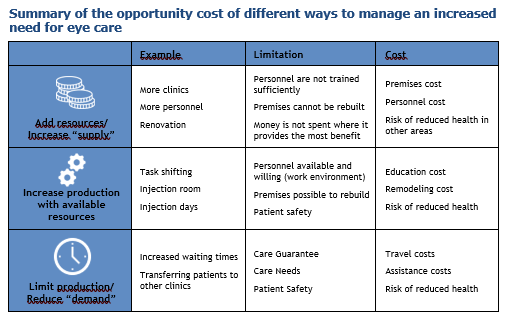
Gralén K, Olofsson S, Haggren I, Urey Adamsson M, Lindgren P
Med blicken på kapacitet – enkätundersökning riktad till ögonkliniker i Sverige
The report is written in Swedish with a summary in English
In eye care, new treatments such as intravitreal injections have made it possible to treat patients in the area of medical retina, for example with wet AMD. The treatment is resource intensive. The number of patients and the number of visits have increased over time according to both the National Board of Health and Welfare and the Swedish Macular Registry. This place demands on a higher capacity in eye care. In this report, we examined the capacity level and input constraints in Swedish eye care using a questionnaire survey.
- The eye clinics estimate that the number of visits for the patient groups within medical retina will increase by an average of 30 percent over the next five years.
- Almost all eye clinics have a shortage of doctors/specialists. This has been partly addressed through various efficiency measures such as task shifting where nurses give intravitreal injections instead of doctors. A majority of the clinics estimate that it is possible to make more efficiency improvements on the personnel side over the next five years.
- Almost all eye clinics have a shortage of premises. This has been partly addressed by establishing so-called injection rooms. A majority of the clinics don’t believe that it is possible to further streamline premises in the next five years.
- Other examples of streamlining mentioned in the survey are technological developments in the form of digitalization and AI that can be used to facilitate assessment, and medical developments in the form of longer treatment intervals or administration in the form of drops. Longer treatment intervals could also reduce the patient burden.
- A majority of clinics assess that there are patients who currently do not receive the care they need and that there is a risk that the patients’ disease progression may be negatively affected. This may be particularly relevant for patients with glaucoma.
- One strategy described for dealing with capacity constraints is to refer patients for care elsewhere but is only used by public clinics. This is expected to increase over the next five years.
- Several results indicate that the capacity shortage appears to be greater among public clinics than among private clinics.
- Approximately half of the clinics believe that they do not get the right conditions based on the framework set by the region. The reimbursement system is considered to have an important impact on the capacity level, but views differ as to whether their own region’s reimbursement system has a positive or negative effect on capacity.
In summary, it appears that the capacity within eye care is insufficient in meeting the need for care. The effects of this depend, among other things, on the clinic’s available resources and the possibility of streamlining, see table. The results of the study indicate that capacity limitations can lead to loss of health in patients who cannot receive care on time and/or to a sufficient extent. This is an important opportunity cost that should be considered for an efficient allocation of resources within eye care.

IHE RAPPORT 2025:6, IHE: Lund, Sweden


